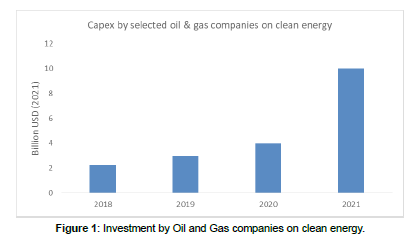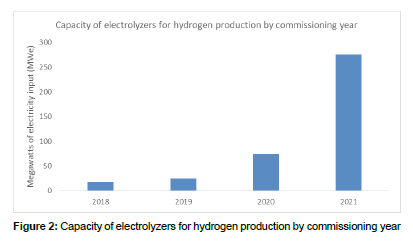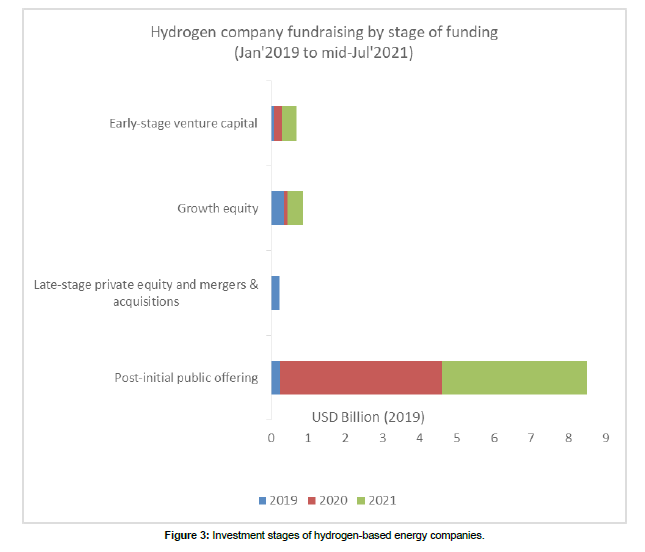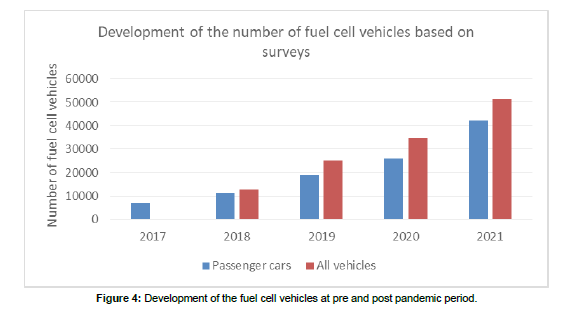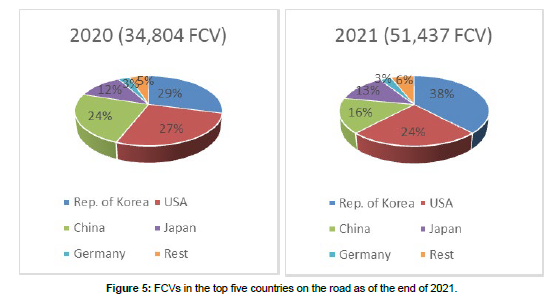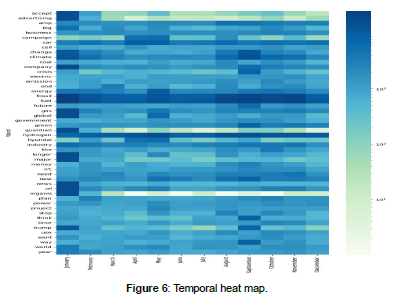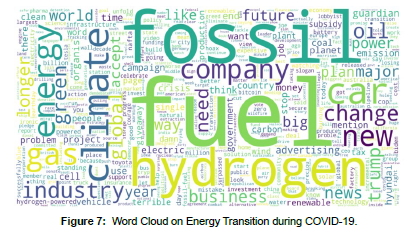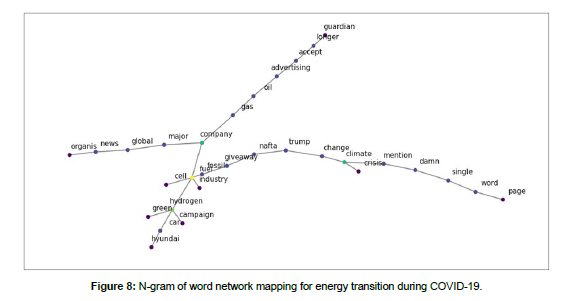A Shift of Global Energy from Oil and Gas to Hydrogen Influenced by COVID-19: A Machine Learning Approach
Received: 03-Jul-2023 / Manuscript No. iep-23-101458 / Editor assigned: 05-Jul-2023 / PreQC No. iep-23-101458 (PQ) / Reviewed: 19-Jul-2023 / QC No. iep-23-101458 / Revised: 24-Jul-2023 / Manuscript No. iep-23-101458 (R) / Published Date: 31-Jul-2023 DOI: 10.4172/2155-952X.1000342
Abstract
The COVID-19 pandemic has played a vital role in the global energy market. The fossil fuel demand faced a great shock and all the relevant projects get severely challenged due to the pandemic and its aftermath. The paper has discussed the impact of the COVID-19 pandemic on global energy transition activities and how it has accelerated the growth of hydrogen energy, and it also contains a machine-learning approach to analyze the post-pandemic sentiment of people about hydrogen energy as an alternative as well as a clean energy source. While COVID-19 has resulted in severe global health and economic crises, it also presents an opportunity for a green, sustainable, and resilient recovery enabled by sustainable energy like hydrogen from a commercial and psychological perspective. The hydrogen economy has been getting more attention and developed countries have been taking all the possible measures to accelerate the shift towards hydrogen energy by making policies and envisaging bigger budgets for hydrogen projects. People all around the globe also have an intriguing attitude toward a hydrogen-fueled greener world.
Keywords
Hydrogen, COVID-19, Oil & Gas, Tweet, Economy, Sustainable Energy
Introduction
The increasing trend of energy consumption leads to more necessity for environmental protection and exploring routes of alternate solutions. However, it is not only the economical or environmental viability; but the positive human psychology that can lead to the transition of energy towards sustainability [1]. The recent COVID-19 pandemic has affected energy transition initiatives as well as the trajectory of energy growth. Since the coronavirus (COVID-19) was first identified in Wuhan, China, in December 2019, the virus has wreaked havoc around the world, necessitating drastic and urgent responses from the World Health Organization as well as local and national governments worldwide to combat the unprecedented global health crisis.
Lockdowns on several levels at the local, regional, and national levels restricted movement and social interaction and resulted in the temporary closure and/or permanent suspension of 80% of companies. Global energy consumption significantly decreased as a result of the slower pace of economic and production activities, which also affected the spread of clean energy [2]. Long hailed as a clean substitute for fossil fuels, hydrogen advocates a perfect opportunity to bring specialized energy into the mainstream of a post-pandemic world as major economies plan green investments to jumpstart growth (“Hydrogen’s Time Is Now in Post- Pandemic World,” 2020).
The success or failure of technological advancement of hydrogen energy is measured in terms of user accessibility, priority, and safety. Unfortunately, there was psychological resistance among mass people to adopt renewable energy due to a lack of under-standing and social advertisement. Renewable energy is rather treated as fearful and impractical in terms of bulk scale compared to conventional energy [3]. But the uncertainty of the oil and gas business during COVID-19 leads mass people to show curiosity about alternative energy, especially hydrogen (Figure 1). Furthermore, the relatively less carbon-free environment and improvement of eco-logical systems accelerate the discussion of hydrogen energy on different kinds of social platforms. This study will attempt to analyze the techno-economical perspective of a clean energy source, hydrogen energy, influenced by the consequence of the pandemic and approach the social perspective to determine the attitude of ordinary people on resistance breaking towards hydrogen energy led by the recent pandemic. This outcome can be used in other countries, for example, or it can be the basis for extensive research on people’s opinions on the subject (Figure 2).
Statistical Analysis of Post-COVID Hydrogen Energy
COVID-19 has affected macroeconomics, behaviors, and policy, that altogether will lower the energy sector CO2 emissions by 27.5gigatons over 2020-2050 [4]. How such alteration has impacted the hydrogen energy is statistically described below (Figure 3).
Post-COVID-19 Energy Transition
In 2021, the refining industry had its first decrease in worldwide refining capacity in 30 years as retirements at 1.8 mb/d exceeded expansions in China and the Middle East, which were rather small in comparison. Given the ongoing uncertainty surrounding the long-term future of oil demand, the recent great financial performance and high utilization rates may not necessarily transfer into higher investment levels. There is pressure on some oil and gas corporations to modify their investments to meet the needs of energy transitions [5].
According to the International Energy Agency (IEA), the expanding worldwide demand for energy services cannot be sustainably satisfied without a major increase in spending on efficiency, electrification, and low-carbon supply.
The Resilience of Hydrogen Energy
Throughout the global pandemic-induced economic slump, hydrogen has shown itself to be extraordinarily durable. Between January 2019 and mid-2021, companies that produce distribute, and use hydrogen raised roughly USD 11 billion in equity, a significant increase from recent years. Contracts supported by government recovery packages are also anticipated to significantly expand project investments (Figure 4).
However, financing is woefully insufficient to spur innovation to the point where it can realize the promise for hydrogen to reduce CO2 emissions by 60 Gt predicted by the Net Zero Emissions Scenario [6].
Post COVID-19 Hydrogen Energy Investment
Hydrogen was unique among fuels in that its prospects were better in mid-2021 than they were before the epidemic, despite setbacks to several projects during the outbreak. Plans for economic recovery all across the world reflect this conclusion. Although the production and use of low-carbon hydrogen are currently limited, expectations for its future growth are higher than ever. In 2020, spending reached record levels in each of the four categories of project planning, project completion, production of equipment, and equity purchases. With the electrolyzers coming online in 2020 alone, the amount of capital expenditure on low-carbon hydrogen is expected to increase. In 2020, 65 MWe of water electrolyze plants for energy purposes were expected to be completed worldwide. Even though this was far less than the 140 MWe that project developers aimed to commission at the beginning of 2020, it was still more than twice the 2019 levels. These electrolyzer projects' anticipated uses for hydrogen included industrial purposes and vehicle fuelling. In Europe, the steel and refining industries have received a lot of attention as potential early markets for captive lowcarbon hydrogen production. However, the majority of the enlarged electrolyzer projects are planned to operate, at least initially, on-grid electricity rather than exclusively producing low-carbon hydrogen. Along with electrolyzer installations, stock investments in electrolyzer technology businesses and investment activities in the manufacturing of electrolyzers both hit record highs.
Companies that are already listed on a stock exchange raised the majority of the additional capital for hydrogen in 2020 and 2021. To raise money for the expansion of manufacturing facilities to satisfy anticipated or contracted demand for electrolyzers and fuel cells, they issued fresh shares to investors. Investor confidence in hydrogen companies persisted through the first six months of 2021, in part because of expectations that contracts will be backed by government recovery programs [6].
Post-COVID global budgeting for Hydrogen Energy
The significant impetus behind hydrogen investment is being fuelled by government action, including money in COVID-19 recovery plans and long-term signals incorporated in national hydrogen programs. Public investment is anticipated to encourage significantly higher private spending, which could hasten the adoption of hydrogen technology. For instance, Germany announced a EUR 9 billion package as part of its national hydrogen strategy, and the German government anticipates that this will spur EUR 33 billion more in private investment. Globally, the business sector is responding with an incredible appetite for investment: the Hydrogen Council reports that the private sector has announced more than USD 300 billion in commitments through 2030, even if only USD 80 billion in funding has been pledged [6].
Post-COVID Deployment of Fuel Cell Vehicles (FCV) and Hydrogen Refuelling Station (HRS) Infrastructure
Figure 04 depicts the growth in FCV usage over the previous five years. While data collection for all vehicles began in 2018, the first statistics from passenger cars are from 2017. It should be mentioned that Toyota Mirai was introduced at the end of 2014 in Japan, and Hyundai began leasing the ix35 Fuel Cell, the world's first massproduced fuel cell vehicle, in the United States in 2014. For passenger automobiles, the highest increase rate of 69% was achieved from 2018 to 2019, following a 56% increase in the yearly deployment rate from 2017 to 2018 (Figure 5).
The COVID-19 pandemic-related worldwide economic slowdown can be blamed for the decrease in the rising rate to 37% in 2020. The rising rate in 2021 was 63% and was close to the peak rate of 69% right before the pandemic, which is consistent with the beginnings of an economic recovery in that year. However, when compared to 2019, with 7701 units, it is obvious that the increase in 2021, with 16,260 passenger cars, is significantly greater. The annual increase rate alone does not accurately portray the development because the number of fuel-cell passenger cars is continually rising; it must be supplemented by the absolute increase. The tremendous increase rate of 95% from 2018 to 2019 did not continue in the following years, according to the development of all FCVs. 2020 saw an increased rate of 38%, which is comparable to the growth rate of passenger cars. An improvement was seen in 2021 with a 48% rise rate in just one year.
The top five nations with at least 1000 fuel cell vehicles on the road as of the end of 2021 are used to compare the shift in global shares from 2020 to 2021. Although the ranking remained the same in 2021, South Korea's vehicle shares significantly climbed from 29% to 38%, which resulted in drops of three percentage points for the United States and eight for China. Germany kept its share at 3% while Japan and the rest of the globe both saw small percentage point increases. Only 31 FCVs are currently registered in China, according to a review of the absolute numbers for that nation. According to an examination of data for several vehicle categories in China, more MD (370 new units) and HD (796 new units, all new) trucks were produced in 2021, but there were 1140 fewer buses. A prior year's overestimation was the cause of the drop. The prior figures, which included planned but unproduced and unutilized vehicles, were provided by vehicle manufacturers, whereas the current figures are based on vehicle registrations in China [7].
A Sentiment-analysis approach to understand the impact of COVID-19 on Hydrogen acceptability
Sentiment analysis, also known as opinion mining, is a computational process that involves identifying, extracting, and categorizing subjective information from textual data [8]. Its purpose is to determine the sentiment or emotional tone expressed in a piece of text, whether it is positive, negative, or neutral. Over the years, sentiment analysis has become increasingly significant due to its wide range of applications and its ability to provide valuable insights into public opinion, customer feedback, and social media conversations. Sentiment analysis is a powerful tool for understanding and interpreting human sentiment expressed in textual data [9]. Its applications span across various domains, enabling businesses, organizations, and policymakers to leverage sentiment insights for better decision-making, customer satisfaction, brand management, and public engagement. By extracting valuable sentimental information from text, sentiment analysis empowers individuals and entities to make informed choices, enhance customer experiences, and stay ahead in a rapidly evolving landscape.
Data Processing and Description
In this study, we have used Twitter data collected through API during two years of Covid-19 peak time. The covid-19 hits USA on a massive scale from March-2019 and the subsequently impacted on energy market during the next couple of years. To identify the evolving topics from USA perspective, we filtered the data for US inhabitants’ tweets. Total, ~0.85 million raw tweets from ~48 thousands unique users were collected by using relevant keywords, geolocation boundary and specific timeframe. For our study, we selected 1 year data started from the first case of Covid-19 detected in USA. In social media like Twitter, the users publish content about many different topics, and a lot of these contents are not relevant to our study. Thus, appropriate filtering is necessary to get meaningful insights from the data [10].
To get the data relevant to a particular disaster, we further filter the datasets by keywords such as ‘alternate energy of oil and gas’ and the name of the alternate energy (‘Hydrogen’, ‘Solar’, ‘Wind’). We only use tweet texts for dynamic topic models because they contain a lot of noisy information that can degrade the quality of the topics. Thus, it is necessary to remove the noise from the tweet text before fitting the data into the model. To be consistent with the tweet language, we take only the English tweets for our analysis. We remove the emoticons from the texts. Although emoticons can represent sentiments and emotions, it is not standardized and hard to interpret. In the tweet texts, users can mention other users starting with @ symbol. Although it might represent some communication pattern, a username does not give any meaningful interpretation within a topic and thus, we remove all the user mentions from the text. We also remove URLs from the tweets because they do not provide any semantically interpretable information. Further, we remove the stop words, punctuation, and special characters (\@/#$, etc.) from the text. Finally, we convert all the tokens/words as lowercase before creating the corpus for fitting the topic model. After applying relevance filtering, the data size is as follows Hydrogen data contains 470,587 tweets with a vocabulary size of 11,872. The tweet data of one-year duration was taken as a sample tool to determine the opinions of the inhabitants of countries in which hydrogen energy is discussed and where the infrastructure for hydrogen energy is asked. Respondents presented their attitude to ecology and indicated their knowledge of the operation of hydrogen energy and the use of hydrogen fuel for future energy demand.
Methodology
The section comprises a brief explanation of methods used for developing the data analytics and infographics in this study.
Word frequency and temporal heat maps
Word frequency is a popular natural language processing (NLP) technique that counts the number of times a word appears in a text assembly and provides a sequential ordering of the counts. The temporal heat map is a sophisticated pivoting technique that displays the frequency of words over a specified time-series. The frequency is represented with a color bar chart. The variations in color sequencing aid in distinguishing the frequency of the words. The top "100" most frequent words in this study were used to generate the temporal heat map with alphabetical sorting (Figure 6).
Word N-grams analysis
Word N-grams is a NLP technique used to define the word probability of “N” number of words appearing in a word sequence. It trims word pairs or triplets (i.e. for bigrams and trigrams) as a single entity and identifies next word probability in the text assembly (Kumar, 2017). The word sequence w1…wN is separated from the order of text observations x1…xT for which the posterior probability:
P (w1…wN | x1… xT) achieves the maximum value. It can be written in the following form:
arg max { P(w1…wN | x1…xT). P(x1…xT | w1…wN) }, w1…wN (1)
Where, P(x1…xT | w1…wN) is the conditional probability of, the given word sequence w1…wN. We obtain the decomposition using the following conditional probabilities:
P(w1…wN) = Wn | w1 … Wn-1) (2)
We can partition the vocabulary of size W in number G of word classes. The category mapping can be written as:
G: w → Gw (3)
Here each word w of the vocabulary is mapped to its word-class Gw. For a word bigram (v,w) we use (Gv, Gw) for denoting the corresponding class bigram. For maximum likelihood estimation, the equation could be written as:
Fbi (ß) = N(w) + (4)
Given,
Fbi = bigram maximum likelihood
W = vocabulary size
u, v, w, x = words in a running text.
N = training corpus size
ß = number of word classes (Martin et al., 1998)
Discussion of findings
Different machine learning techniques were used to define the diversified characteristics of the data source. The outputs were modeled using temporal heat maps with frequent words and word network analysis with n-grams. Each of these techniques provided unique insights and added different dimensions to the results. The following sections provide a synopsis of these methods:
Temporal heat maps with frequent words:
Frequent word analysis is a conventional approach of sorting the words that have appeared the most number of times in a pool of words. Words that have gained popularity undoubtedly provide the gist of discussion on social media platforms. Heat mapping those frequent words allows us to see how these words are stranded over time. It is useful to understand how these words rise and fall over time. In this study, the top 50 most frequent words have been computed as listed in figure 6. Temporal heat maps have been plotted over the year for these top 50 most frequent words and illustrated in figure 6.
The word cloud shown in figure 7 depicts the most frequently used words over the year 2020. These words can serve as an active shift of energy from oil and gas to hydrogen as it incorporates all the aspects of discussion that can emerge in discussions. The word frequency scale varies from the most frequent word fuel (~21 k appearances), fossil (~19 k appearances) and hydrogen (~17 k appearances) to the 50th frequent word planet (~13 k appearances).
It can be observed that the words ‘Fossil’, ‘Fuel” and “Hydrogen” have been discussed with top-most consistence frequency across the whole year of pandemic from figure 6. The hydrogen cell and hydrogen car are mostly discussed just after the Covid outbreak at March-April in United States. This is analogous to previously discussed change of transportation mode due to shutdown at March-15, 2020. Again, the global COVID-19 lockdown caused fossil CO2 emissions to decline by an estimated 2.4 billion tons in 2020. This is mostly felt and discussed during August-September in social media; indicated by the most frequent words, “climate, and “change, green” (Figure 7).
The number of appearances of the top discussed words reveals some obvious similarities with the keywords. The words 'hydrogen' and 'energy' come right after common words like fossil and fuel. It symbolizes people's preference for hydrogen over fossil fuels during the covid pandemic. Other words like 'green,' 'energy,' 'climate,' 'need,' and 'accept' appear together, expressing people's concern about global warming and the need for hydrogen as a fossil fuel substitute. The quick demise of these words, on the other hand, indicates that people's reactions to the need for a "change" in energy mode.
Word network mapping and N-grams
N-gram is a machine learning technique used to compute the sequence of words where N is an integer value. As a result, an N-gram is a sequence of N words (Kumar, 2017). For example, if the words “Alternate-Hydrogen-Energy” appear in the text database N-grams can be computed for up to N = 3 words. For, N = 2 two N-grams can be formed: “Hydrogen-Campaign” and “Clean-Energy”. Whereas, for N = 3 only one N-grams can be formed which is the sequence of words itself. For N = 2,3 values, the N-grams are also known as "bigrams" and "trigrams," respectively. A text database's most common bigrams and trigrams can aid in identifying the most vocal topics of social interactions.
In this study, the top 31 bigrams have been computed for analyses which are illustrated at figure 8. In many instances, it becomes difficult to track the right set of topics with only frequent word analysis. Bigrams and trigrams, which are word pairs and triplets that cooccur in a pool of words, provide a logical explanation for those word frequencies. For example, common words such as car and accept do not provide a complete picture of the associated topics. With bigrams like (car, hydrogen) or (accept, advertising), it is clear that the bigram is related to the hydrogen-powered car being accepted more widely through extensive advertising. Tweets such as "By 2030, this project will be able to undercut any fossil fuel and hydrogen in Europe, upsetting the hundred-year-old status" reinforce the fact that n-grams aid in the provision of substance for recurring discussions (Figure 8).
Bigrams can connect words in a word network map. This efficiently explores bigram interconnectivity and how different bigrams stem from the network. Central nodes have more connections than edge nodes. In a word network, central words are more connected. This shows how different topics have spread across the network from the same word node. This study's top 30 bigrams' word network maps were plotted after multiple iterations for best visualization.
Figure 8 shows one major and several minor word networks. Energy shift from oil and gas to hydrogen is centered on company. It also links to pandemic news. Climate is also central to discussions on energy crisis responses and fossil fuel abolition. The centrality and multiple connectivity of words like company and climate indicate their impact on users' perceptions and concerns on establishing more hydrogen energy companies to address global warming and energy crisis during the coronavirus pandemic (mentioned as virus).
Conclusion
In conclusion, the findings from the analysis using different machine learning techniques have provided valuable insights into the discussions and sentiments surrounding the energy transition during the COVID-19 pandemic. The temporal heat maps with frequent words have shown the consistent discussion of words like “fossil,” “fuel,” and “hydrogen” throughout the year, indicating a shift in energy preferences. The word cloud representation has captured the most frequently used words, highlighting the active shift towards hydrogen as an alternative energy source.
Overall, the combination of temporal analysis, frequent word analysis, word network mapping, and N-grams has provided a comprehensive view of the sentiment and topics surrounding the energy transition during the COVID-19 pandemic. These findings contribute to a deeper understanding of public discussions and attitudes towards alternative energy sources and their potential role in addressing global challenges like climate change and energy crisis.
Author Contributions: Conceptualization, A.N.S. and M.H.; methodology, A.N.S; software, K.I.M.; validation, A.N.S., M.H. and K.I.M.; formal analysis, A.N.S.; investigation, A.N.S.; resources, A.N.S.; data curation, K.I.M.; writing original draft preparation, A.N.S.; writing—review and editing, M.H.; visualization, M.H.; supervision, A.N.S.; project administration, A.N.S. All authors have read and agreed to the published version of the manuscript.
Funding: “This research received no external funding”
Data Availability Statement: Not applicable.
Acknowledgments: Not applicable.
Conflicts of Interest: The authors declare no conflict of interest.
References
- Ingaldi M, Klimecka-Tatar D (2020) People’s attitude to energy from hydrogen from the point of view of modern energy technologies and social responsibility. Energies 13:24,
- Hoang AT, et al., (2021) Impacts of COVID-19 pandemic on the global energy system and the shift progress to renewable energy: Opportunities, challenges, and policy implications. Energy Policy 154:1-24.
- Hydrogen’s time is now in post- pandemic world. Arab News, May 10, 2020.
- How is COVID-19 Impacting the Energy Transition?.
- World Energy Investment 2022, 2022.
- Global Hydrogen Review, 2021.
- Samsun R, Rex M, Antoni L, Stolten D (2022) Deployment of fuel cell vehicles and hydrogen refueling station infrastructure: A global overview and perspectives. Energies, 15:4975.
- Al Momin K, Kays HM, Sadri AM (2023) Identifying crisis response communities in online social networks for compound disasters: The case of hurricane Laura and Covid-19. Transp Res Rec J Transp Res Board May, 2023.
- Kays AM, Momin HM, Thwala KA, Muraleetharan MKK, & Sadri AM (2022) Translating social media crisis narratives into road network utilization metrics: The case of 2020 Oklahoma Ice Storm. arXiv Prepr. arXiv2212.08616., 2022.
- Roy KC, Hasan S, Sadri AM, Cebrian M (2020) Understanding the efficiency of social media based crisis communication during hurricane Sandy. Int J Inf Manage 52:102060.
Indexed at, Google Scholar, Crossref
Indexed at, Google Scholar, Crossref
Indexed at, Google Scholar, Crossref
Citation: Moinuddin H (2023) A Shift of Global Energy from Oil and Gas to Hydrogen Influenced by COVID-19: A Machine Learning Approach. Innov Ener Res, 12: 342. DOI: 10.4172/2155-952X.1000342
Copyright: © 2023 Moinuddin H. This is an open-access article distributed under the terms of the Creative Commons Attribution License, which permits unrestricted use, distribution, and reproduction in any medium, provided the original author and source are credited.
Select your language of interest to view the total content in your interested language
Share This Article
Recommended Journals
Open Access Journals
Article Tools
Article Usage
- Total views: 1485
- [From(publication date): 0-2023 - Dec 17, 2025]
- Breakdown by view type
- HTML page views: 1160
- PDF downloads: 325

